 Pope Benedict visits the creche
Pope Benedict visits the creche
in St. Peter's Square
After Vespers this evening, the Holy Father made his customary visit to the Nativity scene in St. Peter's Square before which he said a silent prayer.
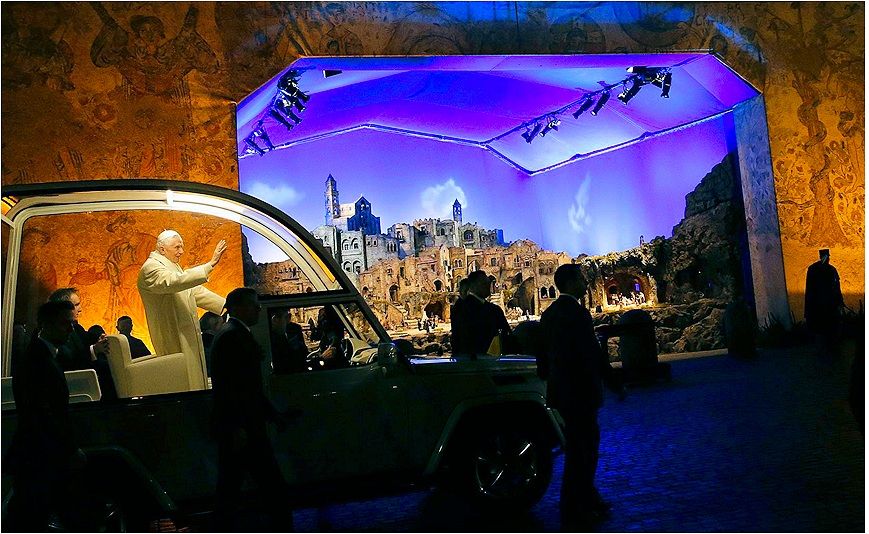
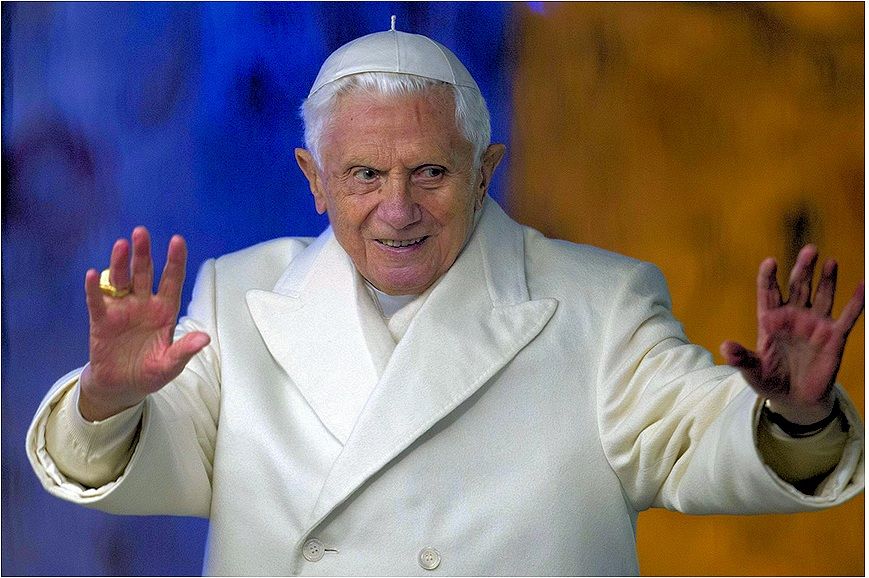
This year's Nativity scene is described in an article in L'Osservatore Romano on the main Nativity scenes in the Vatican this year.
Houses built into rocky hillsides, steep stairways, church steeples rising above the stone dwellings - the Nativity scene in St. Peter's Square this year is visually arresting.
Jesus is born amid a slice of life typical of the Sassi di Matera (literally, 'stones of Matera', referring to the cave dwellings in the Matera area between the southern Italian regions of Apulia and Basilicata, which date back to a prehistoric troglodyte community 9,000 years ago. The settlements, said to be the oldest continuously inhabited communities in the world, became notorious pockets of poverty and disease in modern times until the Italian government, the European Union and UNESCO helped develop the area into a world heritage tourist site. Because its rocky landscape resembles that of ancient Jerusalem, it has also become a location for the filming of Biblical stories.]
Thus the Holy Family finds hospitality amid the peasants of the ancient civilization that flourished in Lucania (the area of southern Italy between the Tyrrhenian Sea and the Gulf of Taranto) and that was focused on local crafts and familial-religious bonds.
The Nativity scene itself is displayed under a modern micropore mesh structure that recreates the frescoes from the most important of Matera's 'cave churches' dating to the Lombard era.
The entire complex is the work of master artisan Francesco Attese and was offered to Benedict XVI by the Basilicata region, with the sponsorship of the Vatican Governatorate.
[TMNews reports a statement today by the president of the Basilicata region, Vito De Filippo, translated here:
The blessing given today by Benedict XVI to our Lucanian Nativity scene situated in the Sassi di Matera is something that directly involves all believers and also goes beyond its spiritual message... In these difficult times for the world, it gives us pride that the Holy Father appreciates the peaceful and modest image that the Lucanian landscape evokes which incarnates a spirit that is useful for the times.
The Lucans of southern Italy, who are often considered among the least fortunate of people, feel tonight that for a change, they come first, and we see this privilege as a commitment to improve and build upon our patrimony of faith and civic virtues.
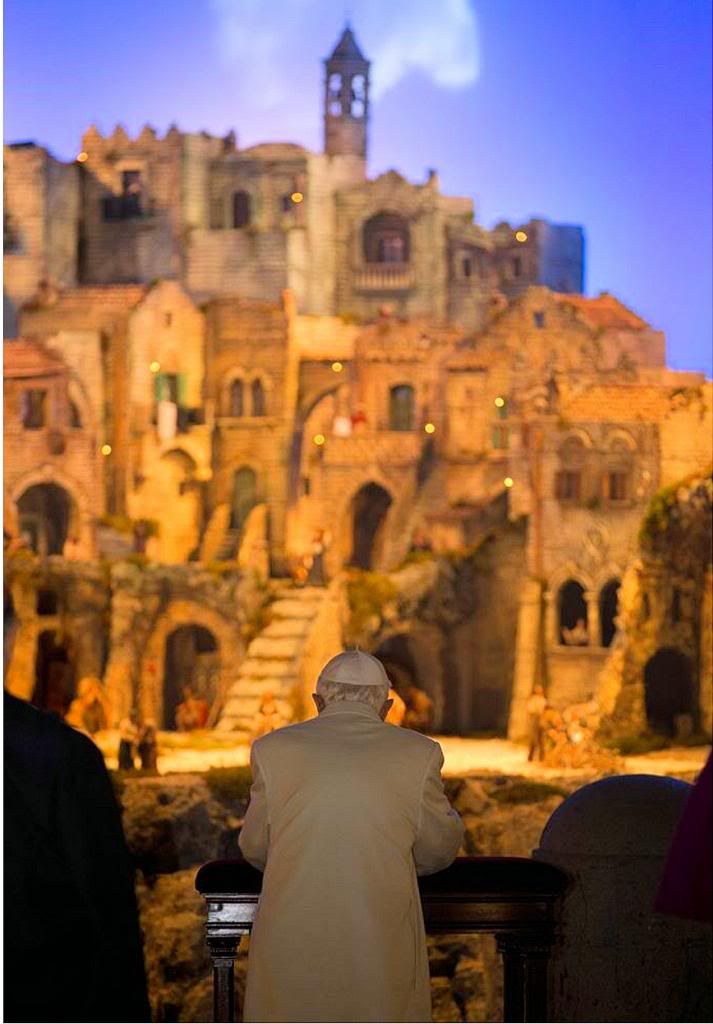
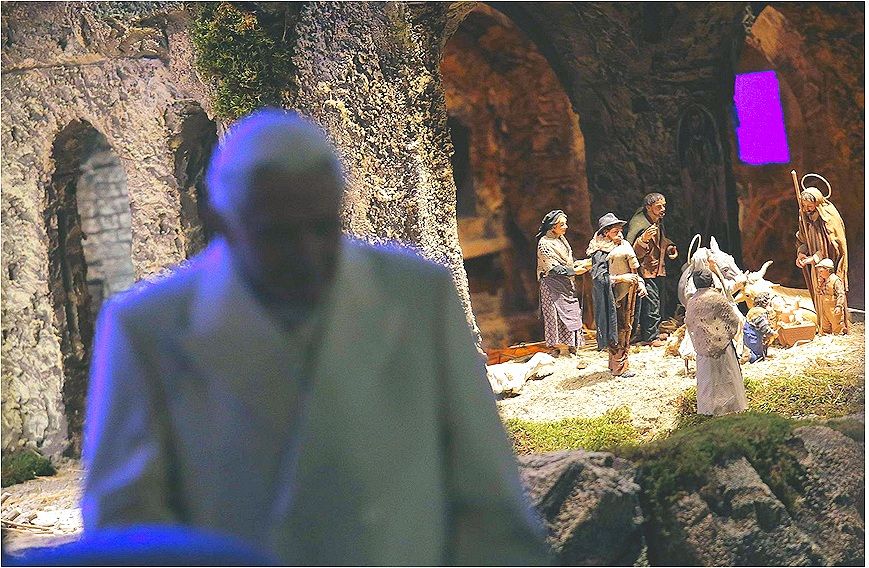
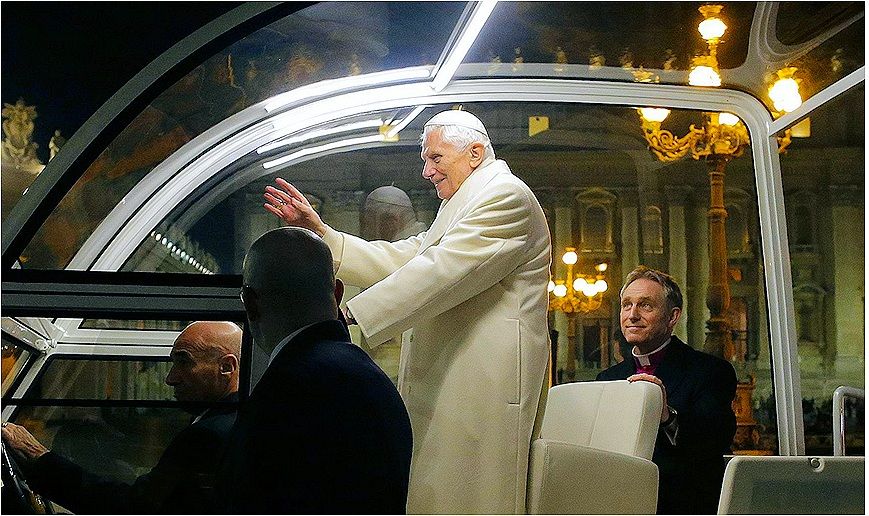
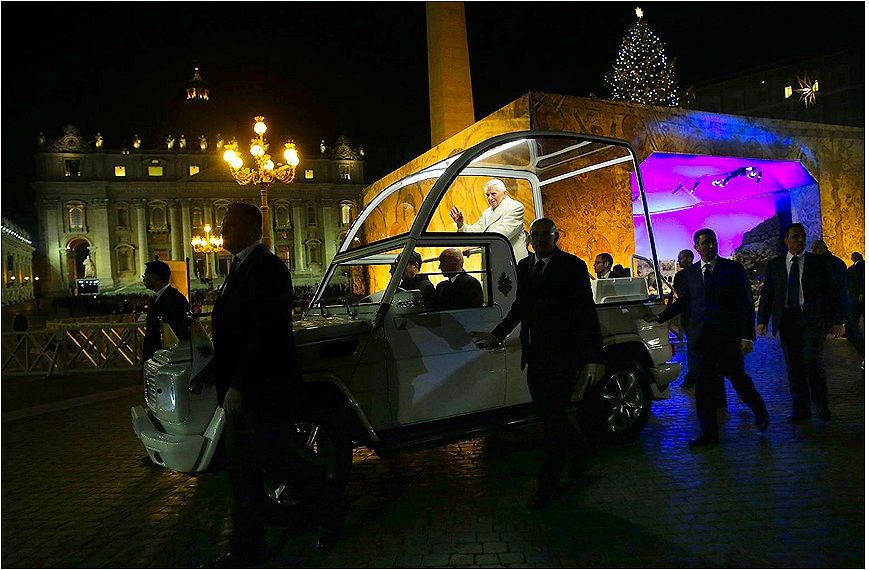 Here's the rest of the OR article about the notable Nativity scenes in the Vatican this year - which is maddening because it describes a number of scenes but the article itself is only illustrated by two miserable thumbnails that fail to convey the scenes described in the story. You would think it would have been an opportunity to do a decent photo spread. But No, editor Vian does not at all think like any editor I know! (It's fine to make up your own rules but only if they improve on accepted journalistic SOP, not when they violate them - and common sense, as well!)
The creches at the Vatican
Here's the rest of the OR article about the notable Nativity scenes in the Vatican this year - which is maddening because it describes a number of scenes but the article itself is only illustrated by two miserable thumbnails that fail to convey the scenes described in the story. You would think it would have been an opportunity to do a decent photo spread. But No, editor Vian does not at all think like any editor I know! (It's fine to make up your own rules but only if they improve on accepted journalistic SOP, not when they violate them - and common sense, as well!)
The creches at the Vatican
by Nicola Gori
Translated from the 12/30/12 issue of

The creche on St. Peter's Square is the first of quite a few Nativity scenes in the Vatican's main buildings and courtyards this Christmas.
From the piazza, we go inside St. Peter's Basilica, with its monumental Nativity scene set up every year by the 'Sampietrini' in the left lateral nave, at the altar of St. Pius X in the Chapel of the Presentation.
The figures, sculpted in wood and painted in polychrome, are the work of German sculptor Henirich Zunterer from Oberammergau [famous scene of an annual Passion Play dating to the Middle Ages], who first presented the main figures of the Nativity as a gift in 1995 to John Paul II. who decided they should be set up in the Basilica.
Over the years, more figures have been added to the scene, and some of them are even mechanized, the latter a gift from Sonia Bernardini, a parishioner of Loreto, to Cardinal Angelo Comastri, Arch-Priest of St. Peter's Basilica (and former Apostolic Legate to Loreto). A device for generating artificial snow was later donated by Antonio Foligno.
Next, we come to the pontifical parish of Sant'Anna (mother of Mary), where this year, the Nativity scene was conceived to mark the Year of Faith. Behind the traditional scenery of the cave in Bethlehem where the Christ Child was born, there looks a great arching door, which is the only exit from the cave, in order to return to daily routine. The great door is the Porta Fidei that we are all invited to pass through. The icon of the Year of Faith is represented to the right of the door.
The parish pries,t Augustinian Fr. Bruno Silvestrini says, "Everyone who accepts the message of the angels - all men of good will - encounter Christ, adore him and then go to tell others the Good News. The artist behind this Nativity scene portrays the most important verbs in the Gospel of St. Luke - to go, to see, to adore, to go back to one's daily life."
The scene, designed by Mariano Piampiani of Tolentino (Macerata), uses dozens of figures sculpted by Antonio Giordano of Monreale (Sicily). Jesus is surrounded by angels in celebration; the shepherds are seen adoring the baby accompanied by their wives and children to watch with wonder what had been announced to them by God's messengers from heaven. The entire scene underscores an essential truth: that God first manifested himself to the poor and to the little ones.
Leaving the parish church of Sant'Anna, we walk towards the sector occupied by the Swiss Guards. On the street that leads to the Bronze Doors of the Apostolic Palace, a creche has been set up over the opening to a well. The figure of a Swiss Guard watches over the Christ Child in the cradle.
Within, in the chapel of St. Martin, Luca Mueller and Carlo Pfister, devised a Nativity scene using special materials, with bricks as a base. They used a small wooden table, with hay and pine cones from the Pontifical villas in Castel Gandolfo, to recreate the Nativity.
In the Church of San Pellegrino, we find the creches set up by the Vatican Gendarmerie - one in the barracks, and one in the church itself. The latter, assembled by Emilio Pressciuttini, makes use of three hollowed out cypress trunks from trees that have fallen down in the Swiss Guard cemetery, The scene is built into the main altar and seems to invite the visitor into the mysteries of the faith.
At the offices of the Osservatore Romano's Photo Services, there is a Neapolitan-style Nativity scene presented to the Pope by the street cleaners of Rome. It is the work of Giuseppe Tani who built it on an artistic pedestal made by Dandolo Foglietta.
At the entrance to Tipografia Vaticana (the Vatican printing press), we find a Nativity scene set up every year by technical director Giuseppe Canesso working with Filippo Graini. The setting is reminiscent of the interior of an Italian home in the second half of the 19th century. In the center is the stall where Jesus was born, surrounded by Mary, Joseph and the Three Kings. Mary gently uncovers the Baby's blanket as Joseph and the Magi gaze at the Baby in adoration. Not far from them, a peasant is milking a cow, a smith is forging an iron instrument on his anvil; a shepherd is shearing wool from a lamb; and a woman is drawing water from the well. Birds are twittering on a bush, animated by a n electric mechanism. All the figures and props were made out of the printing press's daily 'wastes', starting with the boxes that supplies come in to the trimmings from the cardboard and other materials used for bookbinding.
And now we come to the Cortile di San Damaso [the main courtyard through which visitors enter the Apostolic Palace]. Here, the Associazione Santi Pietro e Paolo have their headquarters. For the year of faith, the sodality decided to have a Nativity scene dedicated to Benedict XVI.
It shows important moments in the life of Joseph Ratzinger - starting with the house where he was born in Marktl, on the right, and on the left, the Cathedral of Freising, where he was ordained a priest. In the center, a grand staircase - representing man's ascent towards God - leads to the Nativity scene itself, which is located inside a cave on the slopes of the Bavarian Alps which rise in the background. On the right, one sees the Gothic spires of the Cathedral of St. Peter in Regensburg, to symbolize his academic years, having been a professor there from 1060 to 1977 when Paul VI named him Archbishop of Munich and Freising.
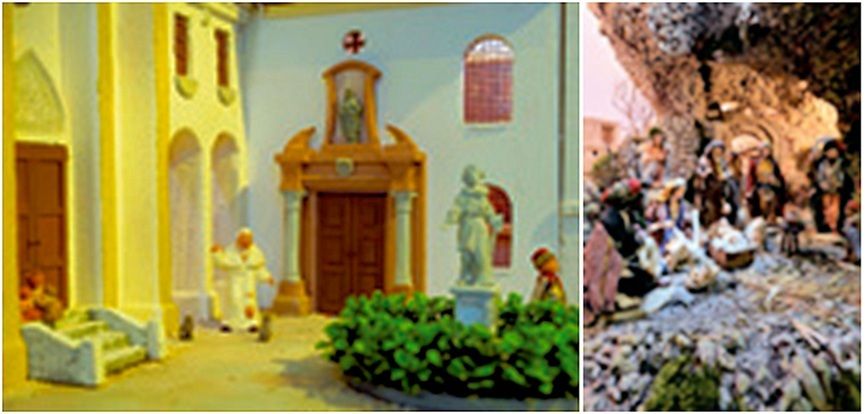
In front of the Freising Cathedral, Benedict XVI himself, as a small figurine, made in Naples, accompanied by two cats.
Lastly, the Nativity scene in the historic seat of the Circolo San Pietro, not at the Vatican, but at the Palazzo San Callisto in Trastevere. It was donated by a member in the early years of the 20th century. The figures are of papier mache, with the Virgin Mary holding baby garments as she tends to the Christ Child. St, Joseph looks on, as the shepherds adore the Baby, as do the Three Kings, richly robed and laden with gifts.
[Modificato da TERESA BENEDETTA 01/01/2013 04:44]